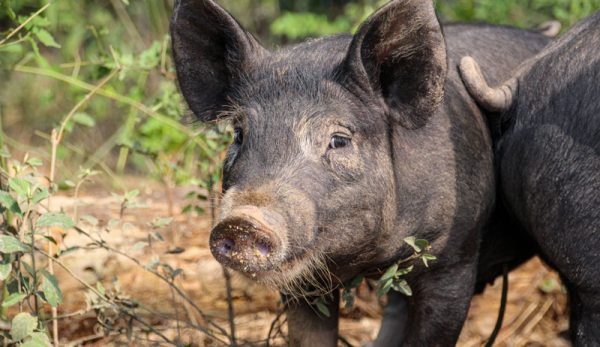
With all its virtues, the homestead pig is one of the most valuable partners you have on the farm. Consider the ways she can help you build a rich, mature compost with a minimum of effort on your part. And she’s even growing your dinner chops at the same time!
When you grill kebabs, even the onions and peppers will owe a debt to the porkers. The compost that makes them so delicious could have been started right in the pig pen.
What Can Pigs Compost?
What’s appropriate for pig composting? Well, almost anything on the farm. Start with a nice bedding of hay or straw, and add whatever spare nutrients you can scare up.
The carbon in the bedding will absorb surplus nitrogen and start a process of decomposition. The end result? Lovely, crumbly black compost that’s perfect for growing your favorite vegetables, fruits and flowers.
And with proper management, your pigs will even turn the compost pile for you. This speeds biological breakdown and ensures good aeration. Really, compost is one of the most important reasons there could be for keeping pigs!
Composting Is an Inside Job
Pigs kept in pens are the easiest to use for compost building. In the pasture or woodlot, pig pressure is less concentrated. Any organic matter gets mixed into the soil.
But even if your pigs live in the field, a few weeks in the barn around harvest time, or in the winter, can go a log way toward building a substantial compost pile and getting its biological processes jump-started.
Next season, your garden will be thanking you for the good, home-processed compost.
Read more: These are the 7 tools you need for handling manure and compost.
The Pig Pen as a Compost Facility
Think of the pig pen as giant compost facility, and the pig as your large-scale materials-handler.
Throw in the bedding from animal stalls and poultry pens. Instead of a manure heap producing flies and ammonia smells, let your pigs turn animal bedding into crumbly black compost, not to mention bacon and sausages.
Toss in the Garden Trimmings
Put all your garden trimmings in the pig pen, along with plenty of dry bedding. Leaves, straw, hay or other high-carbon organic material work great. Then watch how fast they are ground, shredded, chopped and decomposed.
And pigs don’t require fossil fuels. They can get their energy directly from the organic matter itself.
Hydration Is Key
Keeping things appropriately hydrated is as important in the pig pen as it is in the compost pile. That means things should neither get too wet, nor too dry.
Fortunately, it’s easy to adjust the hydration of your pig’s bedding simply by offering additions of hay, straw, leaves, shucks, cobs or stalks. You just need dry, carbonaceous matter that absorbs moisture and locks down nitrogen (the source of a barnyard ‘ammonia’ smell).
Pig urine and spilled drinking water will generally supply all the moisture necessary. Properly hydrated compost breaks down fast and completely, turning waste into black gold. And the process only requires piggy muscles to do it.
Read more: Should you compost? Yes! Here’s how you can get started.
Drop in Some Shell Corn
Encourage your pigs to root in their deep bedding by scattering a handful of ‘shell’ corn (dry, whole corn kernels) into each layer as it is added. Digging for the corn will turn and aerate accumulated organic matter. And this hastens decomposition.
‘Urine’ for a Treat
Urine, often lost by soaking into the soil or by evaporation when animals are kept in the barn, immediately incorporates into deep, fluffy pig bedding. And the valuable nitrogen and other nutrients are saved and built into your farm compost.
Careful husbanding resources results in prize-quality vegetables, fruits and flowers.
Pigs convert waste garden products into pork chops and rich, black compost for growing more vegetables. Think of the animals as near-perpetual energy machines for the homesteaders’ garden.
It would be a shame to overlook all the great possibilities!
Sidebar: Can I Use Wood Chips?
It’s true that wood chips meet some of the most important qualifications for good pig bedding. They are cheap, abundant and high in carbon. But we avoid using them as pig bedding for two reasons:
- They tend to become a hard, packed surface, not particularly absorbent or inviting to a pig’s rooting instincts.
- They break down much more slowly than hay or straw.
Wood chip bedding for pigs commits the farmer to a couple of year’s decomposition, at the very least, before a good garden compost is achieved. Hay and straw, on the other hand, tend to break down quickly—especially so because the pigs look upon them as food.




